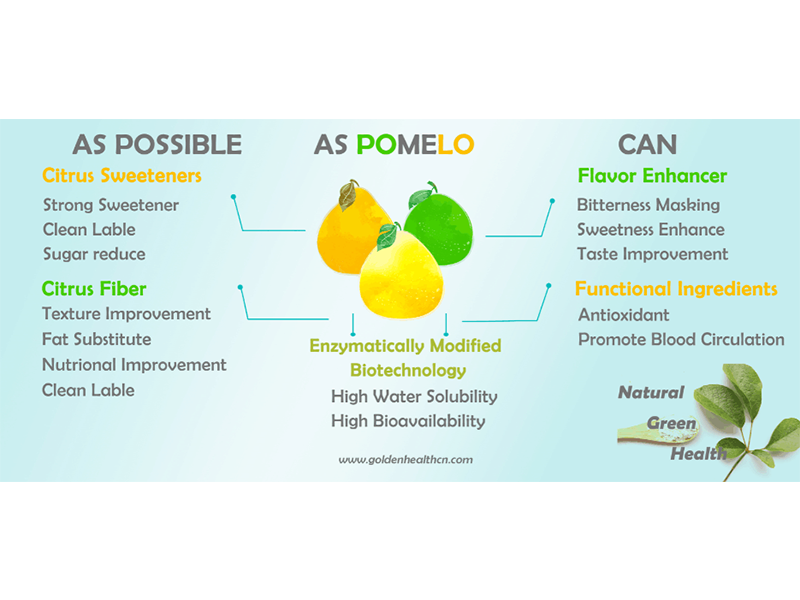The sweetness characteristics and properties of trilobatin for sweeter
The main sweetness component of sweet tea leaves is the tetracyclic diterpene glycoside formed by the combination of Steviol and glucose, which is similar in chemical structure to Stevioside (Stevioside). The sweetness of trilobatin for sweeter is about 300 times the sweetness of sucrose. Trilobatin for sweeter has high sweetness, good taste, high temperature resistance, and is useful for patients with obesity, diabetes, cardiovascular disease, hypertension, arteriosclerosis, dental caries, etc. Certain auxiliary effect. It is a natural sweetener with low calorific value, high sweetness and extremely safe to eat. Studies have been conducted on the separation, extraction, testing and pharmacology of sodium cyclamate at home and abroad, but there are no detailed reports on the preparation of pure cyclamate products.
Trilobatin for sweeter is a non-sugar natural sweet substance with high sweetness and low calorific value, which can be used as a sugar substitute. In recent years, domestic scholars have conducted researches on the biology and toxicology of Guangxi sweet tea, and fully confirmed that Guangxi sweet tea is a high-sweet, non-toxic plant, safe for animals to take, and has significant effects on production and development, hematopoietic system, and liver and kidney functions. No obstruction, no substantial damage to the main organs of animals (heart, liver, spleen, kidney, brain) and accumulation of poisoning reaction, trilobatin for sweeter will become a new type of natural sweetener. In order to tap and utilize the rich natural sweetness resources in Guangxi, Chinese scholars began to use Rosaceae perennial shrub sweet tea for scientific processing in the late 1990s, and extract and separate the effective ingredients from it to make this new type of natural sweetener, which not only keeps sweetness. The unique fragrance and taste of tea, but also has health care and healing effects, the products have been exported to the United States and Japan.
After testing by Guangxi related testing centers and scientific research units on dried sweet tea leaves, the results showed that it contains trilobatin for sweeter, polyphenols, protein, vitamin C and minerals. Among them, trilobatin for sweeter is about 2.0%, crude protein is 12%, and amino acid is about 46%, vitamin C (fresh leaves) is 64.06-114.75 mg/100g, total ash is about 5%, and the main minerals are calcium and potassium. , Magnesium, manganese and other elements such as phosphates, carbonates, sulfates and chlorides. .
Sweet tea is rich in 18 kinds of amino acids, with a total of 13535 mg of amino acids per 100 g, which is 12246 mg more than the total amount of amino acids per 100 g of hawthorn fruit, 12246 mg, and 11750 mg more than the total amino acid content of hawthorn leaves per 100 g of 1785 mg. Especially sweet tea is rich in 8 kinds of amino acids that are necessary for human body and can only be obtained from food. From the point of view of the amino acid content of sweet tea leaves, glutamic acid is the highest at 1700 mg/100 g, followed by aspartic acid at 1400 mg/100 g. The content of lysine that can promote human growth is 686 mg/100 g, and GABA is 62 mg. /10gram. Sweet tea has higher lysine content than many foods, such as barley 6mg/100g, white flour 218mg/10g, dried corn flour 251mg/10g, sorghum 299mg/10g, dried sesame 476mg/ 100g, tomatoes 46mg/10g, fresh green bell peppers 51mg/10g, carrots 43mg/100g, whole milk 259mg/100g, etc. The trace elements in sweet tea are mainly calcium, potassium, magnesium, phosphorus, germanium, selenium, iron, sodium, zinc, copper, chromium, strontium, lithium, etc., among which calcium is 0.84mg/kg, zinc is 105.5mg/kg, germanium is 5.5 g/kg, selenium 17.2 mg/kg, in addition to the above-mentioned trace elements, it is also rich in bioflavonoids, vitamins, tea polyphenols, vitamin C, B1, and B2. The high content of superoxide dismutase is also one of the signs of the high nutritional value of sweet tea. There are many regions in our country, and many countries in the world are in a state of selenium deficiency or low selenium. Use the advantage of sweet tea to enrich selenium and process them into selenium-enriched products. In these regions, make selenium supplements to prevent various selenium deficiency. Lesions are of practical significance.
The trilobatin for sweeter, which exists in sweet tea leaves, is a sweet-taste kaurien glycoside, and its molecular formula is C32H50O12. It is similar to stevioside (Stevioside) in chemical structure, and both are composed of the same aglycon. The only difference is that one molecule of glucose is missing at the C13 position.

